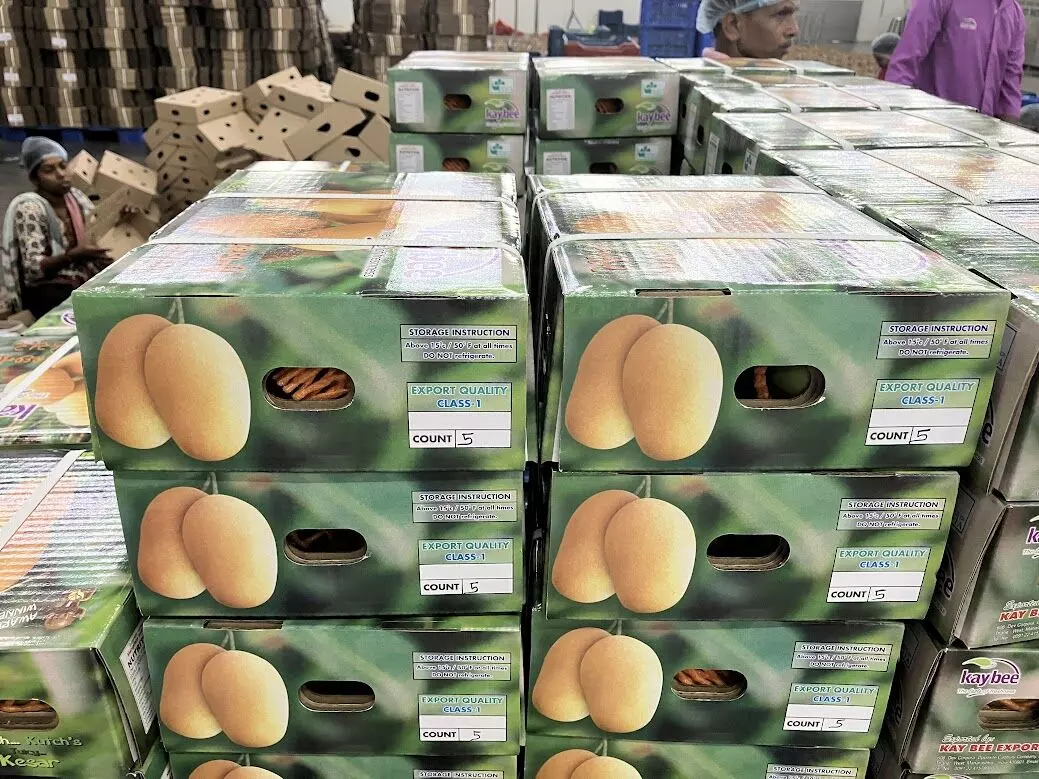India, the world’s largest mango producer, boasts a rich legacy of mango cultivation, with over 1,000 varieties grown. The most popular varieties for export are Alphonso and Kesar, which are known for their exceptional taste and unique characteristics. Mangoes offer numerous health benefits, such as preventing certain types of cancer and improving skin health, and have been a part of traditional Indian Ayurvedic medicine for over 4,000 years.
Kesar mango: A prized varietyThe Kesar mango originates from Gujarat and is one of the most prized varieties. This variety was first cultivated by the Nawabs of Junagarh in 1931 and was named Kesar in 1934. It is known for its saffron-coloured pulp and rich aroma. The Kesar mango offers a sweet and slightly sour taste, tender and juicy flesh, and a fiberless texture. It is also rich in antioxidants, vitamins (C, A, E), and essential minerals like potassium and magnesium, which support a healthy immune system and overall well-being.
Rising demand for Indian mangoesThe global popularity of these mangoes stems from their unique flavour, rich nutritional profile, and careful processes that ensure quality and freshness.
According to an official release by the Indian Ministry of Commerce & Industry, India exported 22,963 tonnes of mangoes worth $48.53 million in 2022-23. Between April and August 2023, mango exports amounted to $47.98 million, with exports to the US expected to more than double this year. Both Kempegowda International Airport in Bengaluru and Chhatrapati Shivaji Maharaj International Airport in Mumbai have seen significant growth in mango exports.
Bengaluru airport recorded a 124% increase, exporting 684,648 kg in 2023 compared to 305,521 kg in 2022. Meanwhile, Mumbai airport saw a surge of 318%, handling 4,700 tonnes in 2023 compared to 1,123 tonnes in 2022.
“Currently, India produces 40% of the world’s mangoes, but only 5% of that is exported,” added Varun Sharma, VP of International Business Development & Sales., Kay Bee Exports, to The STAT Trade Times while discussing the potential of India’s mango exports.
“The typical shelf life of a Kesar mango is 7-10 days from the date of arrival,” informed Sharma. However, ensuring that these mangoes reach consumers while still fresh is crucial. “So, we always harvest the mangoes in a semi-ripe stage. Since we want to ensure a longer shelf-life of mangoes, we let them ripen during transit. By the time they reach the end customers, the mangoes are in the ripe stage,” added Sharma.
Kay Bee Export’s Sharma also informed that the journey from an orchard in India to an end customer in the US or EU typically takes about 48-72 hours. This quick transit time is essential to maintaining the fruit’s quality and taste.
However, maintaining mangoes’ freshness during their journey to international markets involves several critical processes. As highly perishable fruits, mangoes require a controlled temperature range between 22°C and 25°C during transportation. Avoiding extreme temperature fluctuations is necessary to prevent spoilage and preserve the fruit’s quality. This temperature control is a vital part of cold chain logistics that ensures mangoes arrive in optimal condition.
Phytosanitary regulations for mango exports
US & Australia: Irradiation TreatmentJapan, New Zealand, South Korea, and Mauritius: Vapour heat treatment (VHT)European Union, New Zealand, Iran, and South Korea: Hot water treatment (HWT)
To export mangoes to the USA and Australia, they must undergo irradiation treatment to comply with their phytosanitary regulations. Additionally, exports to Japan, the European Union, New Zealand, South Korea, and Mauritius require vapour heat treatment (VHT) to meet import requirements. Furthermore, shipments to the European Union, New Zealand, Iran, and South Korea mandate hot water treatment (HWT).
These treatments are crucial to prevent pest contamination and ensure that exported mangoes meet each destination’s strict quality and safety standards. Adhering to these treatment protocols is essential for facilitating smooth trade and preserving the integrity of mango exports in international markets.
Irradiation is a crucial step in exporting mangoes. This method involves using gamma radiation to eliminate pests and pathogens. The advantages of using irradiation for mangoes include:
Extending their shelf life.Controlling insects that can harm the fruit during storage.Eradicating harmful parasites and pathogens.Ensuring the safety of the food.Preserving the natural qualities of the mangoes.
Sturdy boxes and ventilation are the keyWhen preparing mangoes for export, using sturdy boxes that provide both protection and ventilation is essential. For instance, Alphonso and Kesar mangoes are typically packed in 3.2-3.5 kg boxes, while larger varieties such as Benganpalli and Totapuri are packed in 4.2 kg boxes. These boxes are arranged on standard 1200 mm x 1000 mm pallets in a stable cross pattern to optimise space and stability during transportation.

The careful packaging and palletising process ensure that the mangoes stay fresh and in perfect condition when they arrive at their destination.
It is crucial to carefully position the pallets within the shipping containers to allow for proper airflow and maintain the temperature range of 22°C to 25°C. The careful packaging and palletising process ensure that the mangoes stay fresh and in perfect condition when they arrive at their destination.
India’s mango journey continuesIndia’s export of mangoes showcases the country’s vital agricultural sector and the commitment of its farmers and exporters. Bringing mangoes from local orchards to international markets involves combining traditional farming methods and cutting-edge technologies, guaranteeing that consumers worldwide savour top-notch Indian mangoes. Through each export, India reinforces its status as a prominent global supplier of mangoes, sharing a sample of its diverse agricultural legacy with the worldwide community.





















